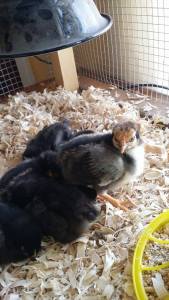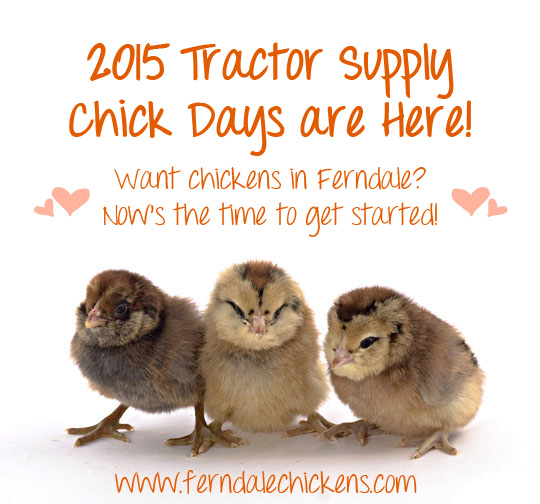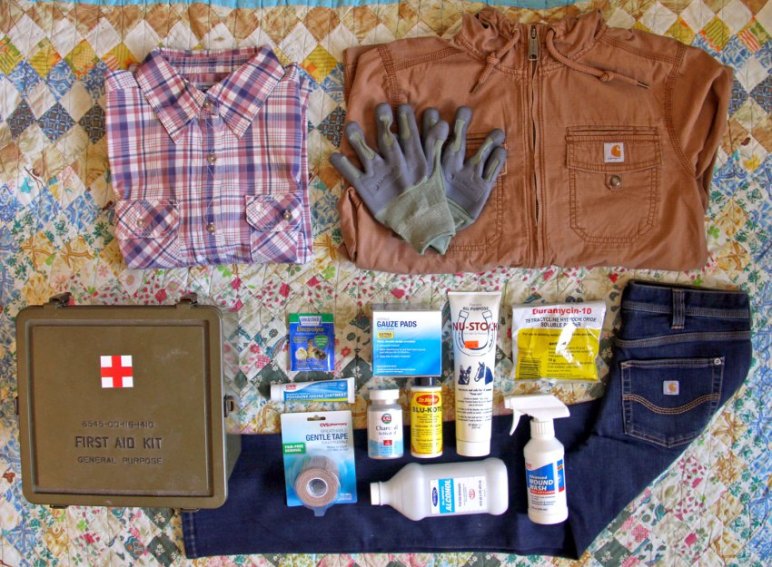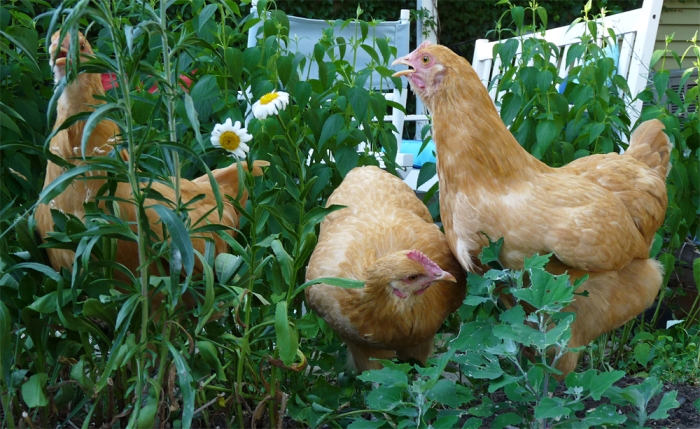If you’ve been thinking about having backyard chickens in Ferndale, MI, now is this perfect time to get started.
Every year in mid to late February, Tractor Supply hosts their “Chick Days”, where they receive shipments of chicks from hatcheries to their retail stores. For your average backyard chicken keeper, these days are a boon: it makes it so much easier to source chicks and visually inspect them before bringing them home, and allows you to take home a much smaller number than would normally be shipped to you direct from a hatchery. My preferred TSC is located in White Lake MI, about 45 minutes away from Ferndale.
Advantages to getting your chicks through TSC Chick Days:
- Chicks can be visually inspected for leg issues, disease, and injuries prior to taking them home.
- No “dead on arrival” chick issues that come from hatchery shipments; most hatcheries will only ship 30+ chicks at a time and often include a few extra to account for those that die en route.
- Supplies for chick rearing are located at TSC- you can get everything you need to get started right there.
- Smaller quantities: TSC requires that you purchase a minimum of 6 chicks. While this is problematic here in Ferndale where we can only have 3 chickens, it’s a far better option than sourcing through a mail-order hatchery that only ships a much larger volume (30+) of chicks per box.
- Chicks are about $4 each. $12 for your 3 hens in Ferndale (plus additional expenses to set up the coop, get feed, set up brooder box, etc)
- New chicks are shipped to stores every Monday. You can call to check what breeds they have every Monday around noon. White Lake’s TSC just had their first shipment delivered today, 2/23/15.
Disadvantages of getting your chicks through TSC Chick Days:
- Limited selection of breeds. If you have your heart set on a certain breed of chicken, you may not be able to get it at TSC. Right now, at the White Lake TSC they have Red Star & Ameraucanas.
- If you’re in Ferndale or a city that limits how many chickens you can have, you’ll need to consider how many of the chicks you can actually keep. You can have 3 hens in your backyard in Ferndale- and NO roosters. This means you’ll need to rehome 3 birds from your Tractor Supply chick run. You can do this by coordinating efforts with others who would like to get started raising chickens, or by rehoming through craigslist or by social media postings. I see a surge in people selling started pullets/chicks around March on Michigan Poultry & Hatching Eggs Forum on Facebook & Metro Detroit Backyard Chickens Forum on Facebook.
Points to keep in mind when getting started raising chicks in Ferndale:
- You might end up with a male chick/rooster, even if you select from sexed chicks labeled as female. There is almost always a chance that you’ll wind up with a male chick, and you won’t know until they get older and their behavior changes & they start crowing. You can limit your risk of winding up with a rooster in a few ways:
- never buy “straight run” chicks, only “pullets”; pullets = sexed as female
- consider selecting sex link chicks– these are chicks who have a distinct visual difference between

The yellow-faced chick turned out to be the only male in the 6 chick group. It was the friendliest & biggest as a chick; as it turned into a juvenile, it suddenly became standoffish and bossier to the pullets. males & females, making it foolproof to separate males & females. Examples of high production common sex link birds are the black sex link (Black Star) & red sex link (Red Star). This is the best option for those who absolutely can’t have a situation where they wind up with a rooster.
- visually inspect slightly older chicks for characteristics of male chicks: look for thicker legs, bigger body, and a much more friendly/bold personality
- You will need a place to raise the chicks. TSC provides brooding kits, but they’re really only suitable for new chicks. You’ll need something bigger before long. This chick brooder box idea board is a great place for inspiration.
- You will need a heat lamp, and will need to secure it. Heat lamps are dangerous and can set wood shavings/sawdust on fire. Be careful by securing the lamp to something stable or in such a way that it can’t fall into the litter the chicks are using in the brooder box.
- You will need chick food. TSC has this, and it’s very cheap. You can get medicated or non-medicated feed; as much as I’m a pseudo-hippy that lives an organic lifestyle, I prefer the medicated feed to avoid potential illnesses among the fragile chicks. You can add in a probiotic to their feed when they are juveniles to ensure that their gut bacteria are all in order.
- You will need a coop for them to live in after they get bigger. In Ferndale, that means you will need to create a permanent structure, and go through the process of getting the building approved. Read more about the muni code & information on building a chicken coop in Ferndale MI. Chicks grow quickly, and will need a place to transition to- and you will look forward to getting them out of your house. Why? Because…

Chicks must be gradually introduced to older hens. In this case, we used a ‘chicken tractor’ to keep the two groups physically separated but able to see each other. - Chicks create a lot of dust & droppings. The droppings are stinky, and frequent. You’ll need to clean the brooder box daily to keep the chicks from stomping around in their own waste. This gets tiresome, but far worse is the dust that’s created. This fine dust WILL coat everything in the same room as the brooder box. It’s not toxic or stinky, but it often comes as a surprise after you’ve had the chicks for a few weeks and begin noticing that all your nice furniture has a fine, pervasive layer of dust on it.
- If chicks get ill, you will need to get them medication immediately. That’s why I prefer having some on-hand, though it needs to be replaced regularly as it loses it’s effectiveness.
- Backyard chickens, much like dogs & cats, are a commitment of time, energy, and money. You will need to make sure they are protected, fed, and healthy- and because they live outside in a world that wants to eat them, that presents its own set of unique challenges. Plan on having to deal with attacks from local wildlife, and secure your coop like Fort Knox. Make sure you have a veterinarian lined up for illnesses. And always arrange for someone to look after them if you’re going away for an extended period of time.
- You will need to ensure that you don’t attract rats. Rats are attracted to food & places to hide: nothing more, nothing less. If you build a coop that won’t allow rats to get inside as well as secure all sources of feed, you won’t have rat problems. If you think you have rats, contact me immediately and I will help you figure out how to get rid of them. Ferndale has a problem with rats in the downtown area due to improperly secured dumpsters, we as homeowners must not provide ‘greener fields’ for the rats to move to.
- People who keep backyard chickens fall in love with them, but not everyone feels the same. By being a conscientious homeowner & chicken keeper, you’ll keep the peace among your neighbors. Keep it clean, attractive, and in-compliance with the law.



































































































